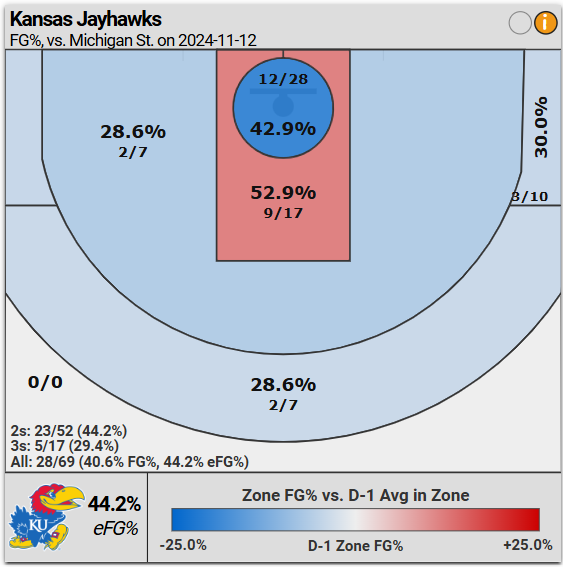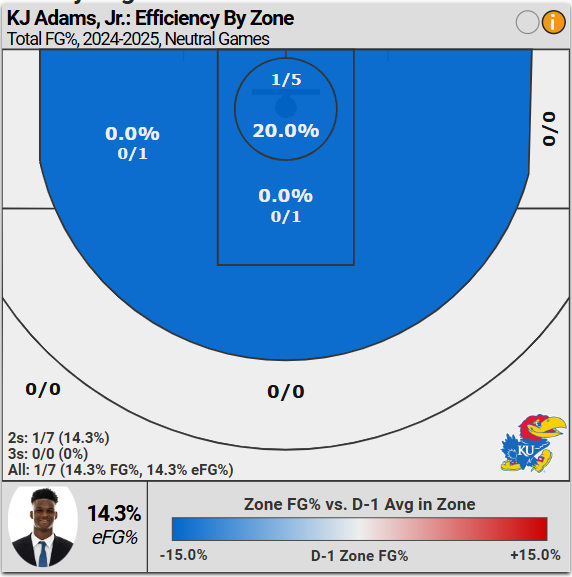Quick Recap - Michigan State
After an expected win against Howard and tight game against North Carolina, Kansas took on Michigan State in the Champions Classic. Here are some takeaways.
Hunter Dickinson rose up again and put in his fourth bucket of the first five minutes, scoring his eighth point and giving the team an 8-2 lead. Kansas felt in control early in the game thanks to their 7’1 center. Michigan State was struggling to finish on the offensive end, and they didn’t have an answer to Dickinson on the defensive end. Then things shifted. Kansas missed their next 15 field goal attempts (missing every attempt after the 15:46 mark until a Rylan Griffen transition bucket at the 7:57 mark), AJ Storr picked up two quick fouls, and KJ Adams picked up two fouls. Despite all of this, a Flory Bidunga dunk gave Kansas a ten point lead with ten seconds left in first half. Unfortunately, a Griffen foul gave Michigan State a four-point play with one second left in the half to cut the Kansas lead to six.
In the second half, Michigan State started strong and tied the game at 52 with 8:52 left on a Jaxon Kohler 3, and it felt like Kansas might have let the game slip away. Duke and Kentucky fans had come into the arena and were loudly supporting Michigan State. Kansas was teetering on the edge of a disappointing loss. The next two minutes were back-and-forth basketball until Dajuan Harris stepped up and took over scoring five points in a 53 second stretch to stretch the Kansas lead from three to eight. The game never felt truly in doubt after that minute.
What were some key factors that led to the Kansas victory, and what were some factors that kept Michigan State within striking distance up until the final minutes?
All images below were taken from CBB Analytics. I’d highly recommend checking them out if you are interested in looking at advanced metrics at a low level. Their visuals and charts are far more user-friendly than a site like Synergy.
The Iceberg
Kansas’ shooting felt like a big issue in the game. Not only did Kansas have a stretch of 15 consecutive misses, they also only shot 5/17 (29.4 percent) from 3. Zeke Mayo went 0/3, Griffen went 2/6, Harris went 0/3, Storr went 1/3, and Diggy Coit went 1/1. While some media analysts were critical of Kansas’ offense after the game, I’m personally less concerned for a few reasons:
It was an arena game, where shooting historically drops. Kentucky went 10/25 from 3, Duke went 4/17, and Michigan State went 3/24. Three teams shot under 30 percent behind the arc Tuesday night, and the idea that Kansas is deficient because of one game is laughable.
The threat of shooting gives Dickinson space to work inside. Michigan State hasn’t historically double-teamed in the post, and Dickinson’s passing ability and the threat of shooters could have caused Izzo to resist adjusting defensively in this game. Even when Kansas isn’t shooting well, the idea that Griffen, Mayo, and Coit could punish opponents helps space the floor on offense. At some point this season, teams will choose to double Dickinson, and the Kansas shooters will need to make them pay.
After the game, the immediate studio reaction was Kansas didn’t perform well enough offensively. Kansas still tied Kentucky as the highest-scoring team in the Champions Classic Tuesday night. While Kansas relied on Dickinson against Michigan State, there will be games where that player is Mayo or Harris or Storr. The point is that Kansas has enough depth that one player won’t typically be asked to score 25 points every single game. Just because it was Dickinson on Tuesday night doesn’t mean that Kansas doesn’t have other options.
Kansas shot 12/28 (42.9 percent) at the rim. In their first two games, Kansas was 33/43 (76.7 percent). While it’s true Michigan State has more size to challenge Kansas at the basket than Howard or UNC (Duke will be similar), Kansas missed a number of easy looks especially during the stretch in the first half where they missed 15 shots consecutively. Zack Clemence had a chance to earn some additional minutes with Adams and Storr in foul trouble, but he missed on two easy looks at the rim. While he did grab two rebounds, there wasn’t much in his performance that indicated he’s in line for more minutes in the future.
KJ Adams and AJ Storr struggled against Michigan State. Adams hurt his ankle against North Carolina and hadn’t practiced since Friday. He was struggling to find his explosiveness and struggled to finish around the rim. That being said, Self still trusts him enough to play big minutes in a close game even when hurt. Some fans feel that Adams limits the offense, but at the same time, he is an elite cutter who plays alongside a great passing center with unmatched athleticism. He plays hard and is a versatile defender, which is invaluable when Kansas is playing against teams that force switches. It’s understandable to want him to score and rebound more, but that’s not where he is most valuable for this team. As long as he plays hard and continues to do what Self asks of him defensively, he will continue to play big minutes.
Storr on the other hand, only had himself to blame for his ineffective game Tuesday night. After closing out the North Carolina game, Storr picked up two quick fouls in the first half and never really got into the groove of the game. Despite this, his 3 to put Kansas up 57-52 with 7:28 left was one of the biggest shots of the game. He keeps showing flashes but hasn’t put it all together. Despite this, Self trusted him to finish a close game last Friday and likely would have played him late if he hadn’t fouled out with 5:55 left against Michigan State. He’s continuing to round into his role, and missed an opportunity to play extended minutes in the first half due to foul trouble.
The Ship
Hunter Dickinson played like a man possessed, scoring 28 points and adding 12 rebounds against his former team’s rival. He was the only consistently efficient player on the offensive end of the floor for most of the game and the reason Kansas won. That being said, there are other pieces of the team that helped the team stay afloat when it could have sunk.
Mayo may not have shot the ball well from the outside, but he added ten rebounds and seven assists. Kansas is a better team when Mayo is contributing points, but his ability to add value to the team in other ways was essential against Michigan State. Mayo’s willingness to hit the boards and create for his teammates is a significant piece to this team finding its ceiling. Through three games he’s been above average in every traditional shooting metric, and that’s more than likely the Mayo we’ll see game-to-game.
As mentioned above, Harris helped Kansas put the game away with his takeover in the second half. He moved into third on Kansas’ all-time assist list and ended the game with six along with 11 points. Harris was the engine that helped Kansas pull away in the second half of the game.
Griffen’s foul before halftime was brutal, but he did make two big 3’s on the game and added another block to his highlight reel. He was the only newcomer that played over 30 minutes (partially due to Storr’s foul trouble), and added ten points and six rebounds.
Self’s decision to play Dickinson and Bidunga at the same time has worked well so far. Bidunga has shown an ability to understand spacing and attacked the rim when on the court. His six points in the first half last night were important easy buckets at a time when most of the team was struggling. Bidunga’s shown a more advanced ability on the offensive end of the floor than expected, and his athleticism and skill at challenging shots is another positive. In games where Dickinson needs rest, Bidunga has proven he’s up to the challenge of playing minutes against top competition. He should only get better as the year goes along.
Coit didn’t have his best night offensively but made the only 3 that he took. He struggled with Michigan State’s length around the rim. However, Coit added in four rebounds on the night in just 12 minutes. As the shortest player on the court, it would make sense if Coit came out of last night with one or no rebounds. Instead he hit the boards hard, played tough (and annoying) defense, and is willing to do the dirty work. That’s a path to consistent playing time.
Self is still working through finding the right lineup combinations due. It’s early in the season, and there’s an excess of talent especially compared to last season. Storr, Adams, and Bidunga all getting into foul trouble against Michigan State pushed Self into playing some unusual lineups. Kansas will likely settle into a more fixed rotation closer to January, but they still have a piece of the puzzle to add in Shakeel Moore who Self has called the team’s best defender. There will still be some experimentations by Self throughout the rest of the non-conference season, but Self will work on getting his top lineup choices more minutes in the games throughout December.
Summary
Despite the apparent struggles on the offensive end, Kansas did enough to win against a talented Michigan State team. They probably should have put the game away sooner and won by more, but they missed quite a few easy opportunities in the first half. If Kansas plays like that against other competition (Duke and Creighton), they have a good chance to lose. Luckily, Kansas has two more games to work on getting into a rhythm before facing off against Duke. The first is on Saturday against an Oakland team who plays a 1-3-1 defense 95 percent of the time, which will be a good chance for Kansas to test it’s ability to play under pressure. An NC State blog broke down Oakland’s defense after their upset over Kentucky in the NCAA Tournament in March. It will be a good opportunity for Kansas’ guards and wings to show that they can raise their level of play around Dickinson. It should be an interesting matchup that Kansas should win, but it’s also possible it will be a challenge.






New subscriber here and great recap! Based upon the foul trouble we saw against UNC (Harris and Dickinson each had 4) and Michigan State, do you anticipate this to be a challenge throughout the season? Or am I reading too much into a two game sample size?